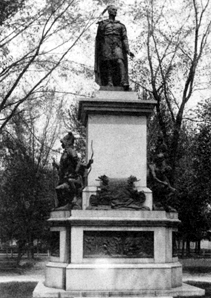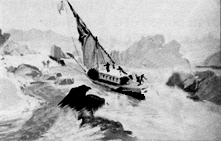Tradition Grows

The Brant Memorial in Brantford, Ontario, honours the Mohawk Chief Joseph Brant, who fought alongside British troops during both the Seven Years' War and the American Revolution. (Library and Archives Canada / PA-66647)
It is difficult to pinpoint reasons for the response of Indigenous people. Many volunteered for the same reasons other Canadians did, i.e. because their friends and relatives did, for patriotism, for the chance of adventure or simply to earn a guaranteed wage.
Some volunteered for reasons that were unique to their band or reserve. One member of the Mohawks of the Bay of Quinte Band attributes his reserve's high enlistment ratio to its ties to Great Britain: "We came over with the United Empire Loyalists from the United States. Our treaties are with the Crown, so, when the Crown calls, you go."18
One Indigenous historian suggests that the Great War offered First Nations men who lived on reserves an opportunity to assume a more active role.19 According to his theory, reserve life had made the role of men less important, a change to which many had difficulty adjusting. He also says, for some, the war presented a chance to escape boredom on the reserve.
Tradition was also a factor in the response. Indigenous peoples in Canada had a well-established history of fighting on the side of Great Britain, dating back to the activities of the Mohawk Chief Joseph Brant during the 18th Century. Brant was just a teenager when he fought with the British in the Seven Years' War. As well, in 1775, he and 1,500 other members of the Six Nations Iroquois (or Long House) Confederacy fought alongside Great Britain's Royal Regiment during the American Revolution.20
First Nations cooperation in British military activity continued over the years. Joseph Brant's youngest son, John, followed in his father's footsteps. As Captain of the Northern Confederate Indians, he fought against the Americans in the War of 1812.

Eighty-six Indigenous volunteers helped guide General Wolseley and his troops up the Nile River in 1884 so they could relieve British soldiers during the Battle of Khartoum. Along with some 300 other Canadians, these Indigenous boatmen were the Nile Voyageurs. (Notman and Son / Library and Archives Canada PA-139815)
Several Mohawks from present-day Quebec journeyed south to join the Ontario Iroquois during this war. The Americans felt their presence most in the second year of the war during the Battle at Beaver Dams, when 180 Mohawks from Kahnawake, Kanesatake and Akwesasne, along with 200 members of the Six Nations of the Grand River, thwarted an American military expedition on its way to Fort George. During the two-hour battle, 15 First Nations warriors were killed and 25 were wounded.21
In all, Great Britain awarded 96 Military General Service Medals to Indigenous soldiers for their military assistance between 1793 and 1814.22
Indigenous people also helped British troops overseas. In 1884, during the Battle of Khartoum in the Sudan, the British put out a call for Canadian volunteers to help guide British soldiers up the Nile River. The soldiers were to provide some relief to the isolated men stationed there. General Lord Garnet Wolseley's group included nearly 400 Canadian boatmen—the Nile Voyageurs—56 of whom were Mohawks23, mostly from the Kahnawake band in Quebec, and 30 of whom were Ojibwa from Manitoba and Northern Ontario.24 Chief Louis Jackson of Kahnawake recommended the design for the whaler-boats that were used on the voyage and became a river foreman. Afterward, he wrote a book about the experiences of the Kahnawake participants. Two Indigenous men lost their lives during the perilous six-month, 19,000-kilometre expedition. This journey turned out to be for naught. The British troops were killed two days before the rescuers arrived.

Like Joseph Brant—his great great grandfather—Cameron Brant chose to come to the aid of Great Britain in wartime. The lieutenant was 28 years old when he was killed near Ypres, Belgium, while leading his platoon in a counterattack.
Many Indigenous recruits of the First World War followed in the footsteps of their Veteran ancestors. One example is Cameron Brant, Joseph Brant's great-great-grandson. He commanded a platoon of the 4th Canadian Infantry Battalion. The 28-year-old lieutenant lost his life in 1915 near Ypres, Belgium, while leading a counter-attack into the enemy's trenches.
For Cameron Brant and many other participants in the First World War, pride in past family achievements may have attracted them to the service. What these men probably did not realize was that they, in turn, would inspire future generations.
- Date modified: